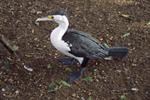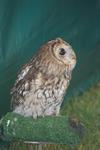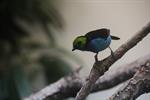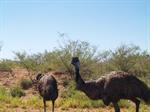 A BIT ABOUT BIRDS...
A BIT ABOUT BIRDS...
With more than 9000 species distributed over nearly the entire earth, birds far outnumber all other vertebrates except the fishes. Birds are among the most beautiful, fascinating and amazing creatures on the planet. Their brilliant plumage, the complexity of their social behaviour and the sheer range of their forms have combined to provide a special attraction. For variety and beauty there is no other class of animal that can come anywhere near the birds. They range in size from the tiny humming birds weighing only a few grams to the giant ostrich, measured in kilograms. Their lifestyle diversity is immense. Birds live in all kinds of habitat from forests to deserts, mountains and prairies, all the oceans and even Antarctica. There are birds that feed on nothing but seeds or nectar and others that pursue living prey by sometimes unique and often ferocious ways; their courtship and mating rituals range from the simple to the highly complex and idiosyncratic, and they demonstrate enormous variety in methods of locomotion and flight. This course will introduce you to many of these amazing characteristics within the world of aves.
Despite continuing interest in ornithology, scientists are still discovering new information about birds. For instance, in 1989, an ornithologist bitten by a Hooded Pitohui (pronounced "pit-oo-eey,") discovered that the bird, found in Papua New Guinea, is poisonous. The Pitohui and two close relatives are the first documented instances of poisonous birds. Just as interesting was the discovery that the poison produced by the pitohui has only been found so far in one frog used by native cultures for dart poison. These frogs and Pitohuis are also somewhat similar in coloration, the most poisonous having the same red and black colouration, and the least poisonous being mostly brown. Clearly, there is still so much to be learned about birds!
A bird is defined in the Oxford Dictionary as "...A feathered vertebrate with a beak, two wings, two feet, egg laying and usually able to fly." This short definition may be greatly expanded. For example, some birds have lost their ability to fly but have retained vestigial wings (eg. emus, kiwis, cassowaries).
A bird belongs to a class of vertebrate animals who share with mammals a constant body temperature and a large brain. The forelimbs have evolved into wings giving most birds the capabilities of flight. Some birds have become flightless as the structure of their wings has changed. These include the ostrich, the emu and the kiwi of New Zealand and penguins. With penguins, the wings have evolved into paddles that enhance their swimming abilities. A bird has a four chambered heart. The bird's anatomy has been designed around flight. A bird must have wings, the bones must be light and hollow yet serve as a rigid frame. The respiratory system must be highly efficient to meet the intense metabolic demands of flight and serve as a thermo-regulatory device to maintain a constant body temperature. They must also eat an energy-rich diet and digest it quickly and efficiently. Above all, birds must have superb vision in order to see during headfirst high-velocity flight.
Want to learn more about birds and caring for birds?
We offer the following courses -
Ornithology
Bird Care
eBook -
Identifying Birds

Courses in ornithology are hard to come by even in universities. Our course is suitable for amateurs and serious twitchers alike. Have a look and if you are interested enrol now or give us call or email and have a chat with one of our tutors.
BIRD TERMINOLOGY
A
Aftershaft: a supplementary feather towards the base of a shaft of a feather in birds.
Air sac: not belonging to the lungs but anatomically attached and involved in respiratory processes. Most commonly nine exists, certain species have more.
Alarm call: calls to signal danger or a threat to other birds.
Albino: total loss of pigment (red or pink eyes).
Allopreening: mutual preening by one bird to another, usually to diminish aggression or to increase bonding in a mating pair.
Altricial: it is generally referred to when the young of animal species are unable to move when they are born and require nourishment, feeding and parental care until they are readily independent.
Alula: a small group of feathers on the “thumb” of the wing which help control air flow over the wing.
Arboreal: most time is spent in trees’
Altitude migrant: a bird that migrates to a different altitude during certain times of the year. Altitudinal migration is common on mountains worldwide, such as in the Himalayas and the Andes.
Anisodactyl: A common foot arrangement in birds with three toes facing forward and one hind toe.
Anting: the behaviour where birds open their wings and allow ants to cover their plumage. The purpose for this behaviour is to reduce parasite numbers through the release of the ants’ formic acid.
Axillary: these are feathers found at the base of the under-wing.
B
Barb: tiny branches found on the central shaft of the feather.
Barbule: minute side braches interlocking the barbs on the central shaft.
Bill: made of bone with a covering of keratin, makes up the birds jaw.
Binocular vision: an overlapping field of vision useful for judging depth.
Biome: an environment defined by living and non-living characteristics’
Breeding Plumage: used to describe the plumage of adult birds displayed when they are in a breeding pair.
Brood: (verb or noun): brood (vb) to sit on nestlings to keep them warm; brood (n.) refers to a group of young birds from a single clutch of eggs.
Brood Parasitism: this phenomenon occurs in some avian species, fish or insects and it generally occurs when offspring are raised and fed by other species.
Brood Patch: an area of thick, featherless skin on a nesting bird’s breast, abdomen or sides, containing a higher concentration of blood vessels in order transfer the parent’s body heat to the incubating eggs.
C
Call: bird sounds that are generally shorter and simpler than songs. May convey a specific message such as alarm calls or contact calls.
Canopy: the upper continuous level of vegetation in a forest, containing the branches of tall, mature trees. The canopy receives most of the sunlight and so has the greatest productivity.
Carpal Joint: the 'wrist' of a bird, forming the bend in the wing, between the arm and the hand.
Carrion: dead animal tissue (fed upon by some birds).
Casque: a helmet-like structure, such as that on the bill of a hornbill.
Cere: unfeathered area incorporating the nostrils above the bill which is a characteristic of parrots.
Chaparral: region of California, consisting of dense stands of broad-leaved shrubs such as chamise and manzanita. This ecosystem is dry, with long hot summers with frequent fires. Rain only falls in winter.
Churring: a low trilling sound made by birds.
Clay Lick: clay banks rich in minerals such as calcium that are visited by seed eating birds such as parrots and macaws who would otherwise lack these minerals in their diet.
Cloaca: common opening at the lower end of the avian tract for the digestive, excretory and reproductive systems. In birds faeces and uric acid are excreted together via the cloaca.
Cloud forest: A habitat that is frequently in the clouds, due to high altitude, hence very moist)’
Clutch: a complete set of eggs laid in an uninterrupted sequence by the same female’
Cock: a male bird’
Collar: a coloured ring around the neck of a bird.
Colony: a large congregation of individuals of one or more species of bird that nest or roost in proximity at a particular location.
Comb: fleshy, erect structure positioned longitudinally on top of the head of a bird often with a serrated margin (like a hair comb) as in domestic chickens’
Contact Call: a sound produced by a bird that appears to inform a nearby bird of the caller’s location. It is often made by a male and female when foraging close together.
Contour Feathers: feathers with well-developed barbules and hooklets that make up the exterior surface of the bird. Includes the wings and tail and help streamline and shape the bird.
Convergent Evolution: the process whereby organisms not closely related, independently evolve similar traits as a result of having to adapt to similar environments or ecological niches e.g. the wings of insects, birds and bats.
Crest: a tuft or growth of feathers on the head of a bird.
Crop: a pouch in a bird’s throat where food is stored or prepared for digestion.
Crop Milk: Milk-like fluid produced mainly by doves, pigeons and flamingos to feed young.
Cyanobacteria: common aquatic plants found in almost every terrestrial and aquatic environment, also known as “blue-green algae” or “blue-green bacteria”.
D
Dabble: a foraging technique used by some ducks in which the bird moves the beak rapidly along the surface of the water to pick up aquatic animals and plant material.
Dawn Chorus: the great volume of bird song heard at dawn. The greatest number of species sing with the greatest frequency than at any other time of day. May be to establish territory.
Decurved Beak: a beak that curves downwards at the end.
Distraction Display: a display in which a bird may feign injury, for example a broken wing, to divert a predator’s attention away from a nest with eggs or young.
Diurnal: active during daylight.
Down feathers: An under layer of soft fine feathers which aid insulation in birds.
Drake: a male duck.
Drumming:
1) Sequence of non-vocal sounds produced by woodpeckers banging on trees or other resonant objects with their beaks to proclaim territory or attract a mate.
2) A series of accelerated muffled ‘thumps’ produced by male Ruffed Grouse to proclaim territory. Made by bringing the wings forward and upwards so creating a sound wave.
Dust bathing: to squat in dusty soil and fluff dust through the plumage, probably performed to combat ectoparasites.
 E
E
Ear Tuft: each of a pair of tufts of longer feathers on the top of the head of some owls. They are unconnected with the true ears.
Echo Location: location of objects by reflected sound as used by oilbirds and swiftlets to find prey when hunting in dark caves.
Eclipse Plumage: the dull plumage developed in some brightly coloured birds after the breeding season which may last over the winter.
Egg Tooth: growth on the bill of the young chick that it uses to break its way out of the egg.
Endemic: found only in a particular region e.g. kiwis are endemic to New Zealand.
Eye Ring: a marking circling the eye.
Eyrie: nest of a large bird of prey; often on a cliff.
Facial Disc: a concave gathering of feathers around some birds eyes.
Feather Tract: areas of a bird’s skin where feathers are attached.
Fledgling: a young bird that has recently fledged or left the nest.
Fledging period: the time it takes a bird to be ready to leave its nest or when it becomes
independent from parental nourishment.
Forewing: Usually the upper-wing coverts (or at least the foremost of these) on the 'arm' of a spread wing.
Frugivore: a bird that feeds mainly on fruit.
G
Gamebird: a bird, such as a pheasant or grouse that is widely hunted for sport.
Gizzard: the lower part of the bird’s two part stomach which has a tough lining and thick muscular walls which grinds and softens food, sometimes with the aid of grit or pebbles swallowed by the bird.
Guano: the accumulation of seabird droppings, particularly in a breeding colony, dried to a hard crusty state. Often mined and used as fertiliser
Gular Sac: upper part of the throat just below the chin. By opening the bill wide and vibrating the thin expansive membranes of the sac, the bird is able to dissipate heat.
H
Hawking: To observe from a perch and snatch a prey or other food sources (i.e. flying insects, fruits) while flying; they may either return to the same branch or fly to a new one.
Hen: a female bird.
Heterodactyl: An arrangement in digits with 2 toes facing forward (digits 3 and 4) and the other 2 pointing backwards (1 and 2). This characteristic is only found in Trogons.
Hindwing: symmetrically paired large feathers preserved along their hind leg bones of some prehistoric birds that might have provided extra lift or created drag in the air.
I
Incubate: the process by which birds keep their eggs at the proper temperature for embryonic development until they hatch.
Insectivorous: feeding on insects.
Irruption –Occasional and usually short lived mass movement of animals that varies from their normal patterns of movement.
J
Juvenile: a young bird.
K
Keel: a mid central ridge of bone that projects outwards from the sternum providing a point of attachment for the large pectoral flight muscles. Large, flightless birds lack a keel.
L
Lamellae: transverse tooth-like or comb-like ridges inside the cutting edge of the bill of birds such as ducks and flamingos which serve as a sieve during feeding:
Lek: a traditional courtship area where many males of the same species gather to attract females for mating by way of displays in competition with the other males.
Lobed Feet: type of feet seen in some aquatic birds which have round cutaneous divisions encircling the toes giving extra propulsion when swimming and preventing the bird slipping when out of the water.
Lores: the area between the bill and the eye, on each side of the face.
M
Mallee: the habitat of woody plants that grow with multiple stems from underground lignotubers which occurs in semi-arid areas of southern Australia.
Mandible: usually refers to the lower half of the beak; also known as the lower beak or lower jaw.
Mantle: area between wings on the top of the body.
Manus: the portion of the forelimb distal to the wrist that provide a point of attachment for the flight feathers.
Migration: the regular movement of all or part of a population to and from an area; usually refers to seasonal journeys to and from breeding grounds or feeding areas.
Mimicry: a situation in which one individual or species has evolved or learned to be similar to another in appearance, sound or behaviour to another species.
Monogamy: mating system in which one male pairs with one female, a least for a given breeding season.
Moult: the process of shedding all or part of the feather coat and replacing it with new growth.
N
Nape: back of the neck.
Nictitating Membrane: a thin, translucent fold of skin that sweeps sideways across the eye from front to back to moisten and clean the eye and to protect its surface.
Nomadic: pattern of movement in which individuals are constantly on the move showing no tendency to return to previously occupied places.
Non Passerine –Any birds that are not members of the order Passeriformes.
Nuchal: refers to the neck.

O
Omnivorous – Animals that can eat both animal and vegetable food, including insects.
Orbital: the area of skin around the eye.
Oscine: member of the suborder Paseri also known as songbirds. Oscines have a particularly complex voice box allowing them to sing more varied songs than other birds.
P
Pelearctic: of or relating to the biogeographic region that includes Europe, the northwest coast of Africa, and Asia north of the Himalaya Mountains.
Pelagic: of the ocean; pelagic birds spend most of their life on the open sea, feeding at the surface or just below it and only coming to land to nest.
Polyandry: mating system in which one female, mates with several males within the same breeding season; a form of polygamy.
Polygamy: a mating system in which individuals of one sex (either male or female) mate with more than one partner during the same breeding season.
Polygyny: mating system in which one male, mates with several females within the same breeding season; a form of polygamy.
Porpoising: to leap clear off the surface at interval lapses of time. Mechanism generally
achieved by penguins in order to reduce bubbles and reach high speed for hunting.
Precocial: when the young of certain species are able to move about once they are born and require little or no parental care.
Preen gland: a gland located at the base of the tail on the dorsal side of the bird’s body which secretes oils that birds spread over their feathers during preening to keep them supple.
Preening: feather maintenance behaviour in which a bird grasps a feather near its base then nibbles along the shaft toward the tip with a quivering motion to clean and smooth the feather.
Primary feather: the flight feathers of the outer wing that are attached to the manus.
Puna – A diverse ecosystem comprising wet, moist or dry mountain top grasslands (over 3,200m elevation).
Q
Quill: a feather.
R
Ratite: referred to a group of flightless birds (superorder Palaeoghathae).
Raptors: birds that hunt vertebrates and other birds primarily via flight.
Rictal Bristles: stiff, hair-like feathers projecting from the base of the beak in birds that catch insects; may help to protect the face and also to detect movements of prey held in the beak.
Rookery: 1) a collection of rooks’ nests high in a group of trees; 2) a breeding colony of seabirds, especially penguins.
Roost: a place where birds regularly gather or settle to rest.
S
Sally: a short flight to perch or catch food.
Salt gland: a gland, located in the head of seabirds that secretes into the nasal passages the excess salt imbibed or ingested.
Savannas: open grasslands with trees widely spread apart.
Scrape: a shallow depression created by certain types of birds (e.g. plovers and penguins), for use as a nest. It usually contains little of no nest material but may be lined with a few pebbles.
Secondary Feather: the flight feathers of the inner wing attached to the ulna of the antebrachium.
Sedentary: to stay in a particular location as opposed to migratory.
Sexual Dimorphism: a situation in which males and females of the same species differ from each other in size or form.
Soaring: in which a bird flies without flapping its wings, while gaining altitude or remaining horizontal.
Song: loud vocalisation, often delivered from an exposed perch, which is presumed to attract a mate or to repel territorial intruders.
Speculum: a patch of often iridescent colour on the secondary feathers of most duck species. The colour will vary by species, as will its width and any non-iridescent borders.
Sternum: the breastbone; it provides an attachment site for the ribs and pectoral muscles.
Steppe – Large grassland areas generally characterised by a semi-dry or humid continental climate and absence of trees, unless nearby rivers or lakes are present.
Stooping: a foraging technique used by falcons in which the falcon drops through the air (at great speed) when in pursuit of another flying bird.
Supercilium: striped area of feathering running above the eyes as seen in many passerines.
Syrinx: the sound-producing organ of birds located at the point where the trachea divides to form the two bronchi.
Syntadactyly: It refers to the arrangement of digits where two of them are fused together, commonly found in kangaroos, siamangs and certain birds such as hornbills and bee-eaters, among others.
T
Talons: sharp hooked claws on the leg of birds of prey.
Tarsus: the upper section of a bird’s foot between the heel and the toes.
Threat Display: any pattern of threatening or startling behaviour designed to scare off or momentarily distract a predator, thus giving the bird an opportunity to escape.
Tobogganing: generally referred to when penguins slide on their bellies across the snow.
Torpor: a state that appears like sleep, but where heart rate and other body processes slow down (It is more like hibernation).
Trachea: the tube or windpipe that conducts air from the larynx to the lungs.
Twitcher: a birdwatcher who travels significant distances in an attempt to see birds.
V
Vagrant: a bird that has moved away from its flock.
Vane: the broad, flat surface on each side of the shaft of a contour feather, formed by the interlocking if adjacent barbs.
Vent: the opening of the cloaca to the exterior of the body.
Vertebrata: asubphylum from the phylum “Craniata”, constituting the vertebrates animals (chordates with backbones).
Vestigial: related to a body part that has become small and/or lost its use; rudimentary.
W
Wader: can also be referred to as a ‘wading bird’, which are characterised for having long legs, long necks and long bills, and can walk partially immersed in water, generally in search of food.
Wattle: a fleshy growth hanging under the bill that has no feathers.
Wingbar: one or more stripe-like areas of different colouration running across the wing.
Wing Loading: the ratio of body weight to wing area thus giving a measure of how much ‘load’ each unit of wing must carry.
Z
Zygodactyl: an arrangement in digits with 2 toes facing forward (digits 2 and 3) and the other 2 pointing backwards (1 and 4).
